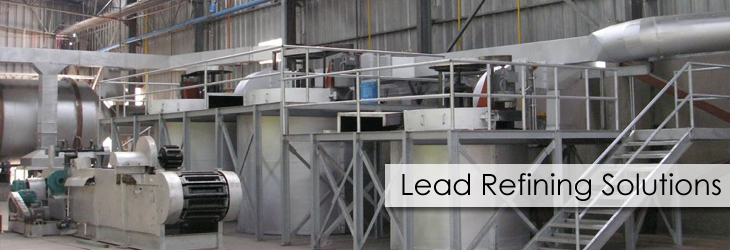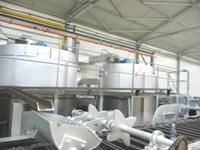  |
|||
An Eco-friendly Engineering Solution for Lead
|
Lead Refining Technology |
|
Company also provides additional equipment for automatic dross removal. On demand, Gravita also supplies range of special fluxes designed to reduce dross formation and increase process efficiency. The refining unit complement is completed by the automatic Lead ingot-casting machine (with Lead-Pump) having a production capacity of up to 10-20 MT/hr. Refining unit package is optimally configured for high throughput with good emission control, as proven by the existing installations in operation. |
Recycled Lead Processing - Refining
A smelting plant stops at the stage of the fusion-reduction plant; it will produce what is known as hard or Antimonial Lead. If the plant is meant to produce soft Lead, the crude Lead must undergo a refining process. The objective of the refining process is to remove almost all copper (Cu), antimony (Sb), arsenic (As) and tin (Sn), since soft Lead are not allowed to have more than 10g per ton of these metals. Pyrometallurgical RefiningPyrometallurgical Refining is performed in liquid phase, which means that the crude Lead must be melted to temperatures from 327ºC (Lead fusion point) to 650ºC. As a general trend, the process is performed in batches of 20 to 100 tons, according to the refining plant capacity. The chemical concept behind the refining process is the addition of specific reagents to the molten Lead at proper temperatures. These reagents will then remove the unwanted metals in a specific order as they are added selectively.Copper (Cu) is the first element to be removed with elementary Sulphur in a two phase procedure. In the first step, almost all copper is removed as a copper sulfide (CuS) skims when elementary Sulphur is added to the molten Lead at 450ºC. The second step is meant to remove all remaining copper by adding small amounts of elementary Sulphur to the molten Lead at 330ºC until no reaction takes place anymore. This process of Copper removal with the help of Sulphur requires reducing of the temperature of the furnace means heat loss. Gravita by its continuous R&D efforts has developed a reagent named "Catalyst GX" which can be added even without reducing the temperature thereby saving fuel. Tin (Sn) is next removed by either chlorine (Cl2) or ammonium chloride (NH4Cl) oxidation. The addition of chlorine to the molten Lead at 500ºC produces tin chloride (SnCl2) skims which are mechanically removed. Although this is the current method for tin removal, its inconvenient is the parallel removal of small amounts of antimony (Sb) and arsenic (As) by oxidation. Arsenic (As) and antimony (Sb) are selectively removed by oxidation with either air enriched with oxygen (O2) or a mixture of sodium nitrate (NaNO3) and sodium hydroxide (NaOH). The temperature of the molten Lead is raised to 550ºC and a flow of O2 enriched air is bubbled into it. The reaction is extremely exothermic and the temperature easily reaches 650ºC. Those skims are a mixture of oxides (25% Sb, 10% As and 65% Pb). Silver (Ag) come next and its removal is carried out by the Parkes Process, which makes use of the preferential solubility of silver in molten zinc (Zn) instead of molten Lead (Pb). Therefore, metallic zinc (Zn) is added to the molten Lead at 470ºC and the mix is allowed to cool to 325ºC. A silver –Lead zinc alloy separates and forms a crust on the surface. The crust is removed and the zinc separated from the silver by vacuum distillation. The crude silver is further refined using oxygen to produce fine silver. The excess of zinc is removed from the de-silvered Lead by vacuum distillation and then by Sodium hydroxide (NaOH). |


 Gravita’s Refining Plant uses pyrometallurgical process for Lead Refining, producing Lead with a minimum purity level of 99.97% from Smelting furnaces tapped crude Lead. Company supply Refining Kettle Furnaces of various capacities ranging from 5-100 tonnes per batch, accompanied by high efficiency natural gas / LPG burners / furnace oil burners, equipped with preheating arrangements. Emissions are controlled by a flexible kettle hood, with series of Pollution Control Equipments chained with Wet Scrubber, attached to an Induced Draft Fan along with a chimney/stack arrangement.
Gravita’s Refining Plant uses pyrometallurgical process for Lead Refining, producing Lead with a minimum purity level of 99.97% from Smelting furnaces tapped crude Lead. Company supply Refining Kettle Furnaces of various capacities ranging from 5-100 tonnes per batch, accompanied by high efficiency natural gas / LPG burners / furnace oil burners, equipped with preheating arrangements. Emissions are controlled by a flexible kettle hood, with series of Pollution Control Equipments chained with Wet Scrubber, attached to an Induced Draft Fan along with a chimney/stack arrangement. The removal of impurities and other metals from the crude Lead (S, Cu,Ni, As, Sb, Bi, Ag, Au, etc.) is Refining. The refining process is applied in several steps in kettles with addition of specific agents alternatively smaller quantities are processed by electrolytic refining.
The removal of impurities and other metals from the crude Lead (S, Cu,Ni, As, Sb, Bi, Ag, Au, etc.) is Refining. The refining process is applied in several steps in kettles with addition of specific agents alternatively smaller quantities are processed by electrolytic refining.


